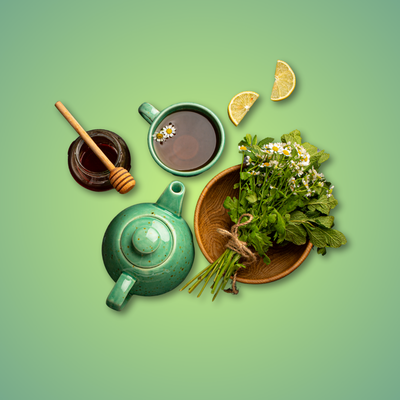The lotus flower, with its serene beauty rising from muddy waters, has captivated hearts and minds for centuries. Beyond its aesthetic appeal, this remarkable plant offers a treasure trove of benefits, particularly in the form of lotus leaf tea. This gentle infusion, steeped in tradition and increasingly recognized for its potential wellness properties, invites us to explore a world of tranquility and well-being. Join us as we delve into the fascinating realm of lotus leaf tea, uncovering its history, preparation, sensory profile, health benefits, and how you can incorporate it into your daily ritual.
What Exactly is Lotus Leaf Tea? More Than Just a Pretty Leaf
Lotus leaf tea is an infusion meticulously crafted from the leaves of the Nelumbo nucifera plant [1]. This plant, revered across Asia, is commonly known as the sacred lotus or Indian lotus, and its leaves, when dried and steeped, yield a beverage that has been cherished for generations [4]. While the term "lotus tea" can sometimes refer to infusions made from other parts of the lotus plant, such as the flower, root, seeds, or embryo, our focus here is specifically on the tea derived from its verdant leaves [1].
The recognition and use of lotus leaf tea span various cultures across Asia, evident in the multitude of names it carries. In China, it is known as liánchá (莲茶, 蓮茶) or Héyè (荷叶) [1]. Koreans refer to it as yeonnip-cha (연잎차, 蓮葉茶) [2]. While Vietnamese trà sen often denotes green tea scented with lotus flowers, the tradition also includes infusions made from the lotus leaves themselves [1]. In English, you might also encounter it as Indian lotus leaf tea or sacred lotus leaf tea, reflecting the plant's esteemed status [3]. This diversity of names speaks to the long history and cultural integration of this tea across different Asian regions.
Steeping in Tradition: How to Prepare and Enjoy Lotus Leaf Tea
The preparation of lotus leaf tea is steeped in tradition, with various methods passed down through generations. In Vietnam, elaborate techniques have been developed to capture the very essence of the lotus plant. One such method is the quickly-scented lotus tea, where high-quality green tea leaves are nestled inside a fresh lotus flower bud overnight [10]. This intimate contact allows the tea to absorb the delicate fragrance of the blossom, resulting in a uniquely aromatic brew. Another refined approach is the well-scented lotus tea, a more labor-intensive process involving alternating layers of green tea and the fragrant lotus rice (stamens) in a basket lined with lotus leaves [10]. This layering and repeated scenting and drying over several cycles ensure the tea is deeply infused with the lotus aroma, yielding a tea of exceptional quality. Historically, the Vietnamese even utilized the morning dew collected on lotus leaves as the water for brewing, believing it imparted a special purity and flavor to the tea [10].
In Korea, the preparation of yeonnip-cha involves a different approach. Young lotus leaves are often heat-treated, either by steaming or roasting, before being dried [2]. This process likely helps to preserve the leaves and enhance their flavor profile. Regardless of the specific technique, a common method for preparing lotus leaf tea involves simmering the dried leaves in water [2]. Typically, about 6 to 12 grams of dried leaves are simmered in 600 milliliters of water for two to three cups of tea [2]. Some sources suggest using water heated to over 85°C (approximately 185°F) and steeping for about 3 to 5 minutes to extract the optimal flavor and aroma [11].
Traditionally, lotus leaf tea is enjoyed as a warm and soothing beverage [11]. In Vietnam, it holds a special place in their culture, often served during celebrations and festivals as a symbol of elegance and tradition [14]. Its historical significance is further underscored by its past as a prestigious drink reserved for Vietnamese royalty [10]. Beyond its cultural uses, lotus leaf (He Ye) has a long history of application in Traditional Chinese Medicine (TCM) [3]. In TCM, it is often used in specific herbal formulas and prescribed for various health conditions, with a typical dosage ranging from 3 to 9 grams [3]. Interestingly, in some regions, particularly during the hot summer months, lotus leaf tea is also enjoyed as a refreshing cold drink, highlighting its versatility [13].
A Symphony of Senses: Taste and Aroma – What to Expect in Your Cup
When you steep lotus leaf tea, you can anticipate a sensory experience that is both delicate and intriguing. The taste is often described as mild and subtly sweet, offering a gentle refreshment [17]. Some discern subtle earthy undertones and a pleasant aftertaste, while others note a delicate sweetness that emerges after the initial sip [11]. However, it's worth noting that a slight bitterness can sometimes be detected, especially if the tea contains even a small amount of the lotus seed embryo, which is known for its bitter properties [21]. One description even characterizes the taste as somewhat savory and lingering, suggesting it might be an acquired preference for some palates [22]. The overall taste experience can also be influenced by whether the lotus leaf is enjoyed on its own or as part of a blend with other teas like green or black tea.
The aroma of lotus leaf tea is typically floral and fragrant, often accompanied by hints of fruit or a subtle earthiness [18]. Many describe it as having a distinct "fragrance of Lotus leaf" or a "rich floral and fruit aroma" [18]. The scent is often considered a key component of the tea's appeal, contributing to a soothing and relaxing effect [20]. The aroma can be particularly pronounced and delightful after brewing, filling the air with a refreshing lotus fragrance [11]. Research suggests that incorporating lotus flowers, especially those withered for about eight hours, can enhance the tea's aroma, making it even more appealing [25].
Unlocking Wellness: Health Benefits of Lotus Leaf Tea – Ancient Wisdom and Modern Science
For centuries, traditional medicine systems have recognized the therapeutic potential of lotus leaf. In Traditional Chinese Medicine (TCM), lotus leaf (He Ye) has been a staple for addressing "Summer Heat," supporting healthy digestion, and even helping to stop bleeding [3]. It has been traditionally used for ailments such as diarrhea, fever, and nosebleeds [3]. Historically, lotus leaf has also been employed to aid in weight management, likely due to its diuretic effects and potential to boost metabolism [19]. Furthermore, traditional practices have utilized it to support digestive health and alleviate common issues like bloating and indigestion [23].
Modern science is beginning to explore and validate some of these traditional uses. Studies indicate that lotus leaf is rich in flavonoids and alkaloids, which are potent antioxidants that can help neutralize harmful free radicals in the body [8]. Specific antioxidant compounds found in lotus leaf include quercetin, catechin, and chlorogenic acid [8]. These compounds suggest a potential role in protecting against chronic diseases linked to oxidative stress. Research, primarily in test tubes and on animals, also points to the anti-inflammatory properties of compounds found in lotus leaf, which may help to reduce inflammation in the body [8]. Some animal studies suggest that lotus compounds might help regulate blood sugar levels and improve insulin sensitivity, which could be beneficial for individuals managing diabetes [8]. Lotus leaf tea is also frequently associated with weight management. It is believed to boost metabolism, inhibit fat absorption, and reduce fat accumulation [15]. Its diuretic properties may also contribute to a reduction in water weight [23]. The antioxidants present in lotus leaf tea may also contribute to cardiovascular health by helping to protect the heart and potentially lowering blood pressure and cholesterol levels [23]. The high fiber content of lotus leaf can also promote healthy digestion and regular bowel movements [8]. Additionally, some research has found that lotus leaf extract exhibits antibacterial effects against bacteria that can cause cavities and gum infections [8].
To provide a clearer overview, the following table summarizes the potential health benefits of lotus leaf tea, distinguishing between traditional uses and those with some scientific backing:
|
Benefit |
Traditional Use |
Some Scientific Evidence |
Notes/Context |
|
Antioxidant |
Yes |
Yes |
Rich in flavonoids and alkaloids. |
|
Anti-inflammatory |
No |
Yes |
Primarily in vitro and animal studies. |
|
Blood Sugar Regulation |
No |
Yes |
Primarily in animal studies. Caution advised for those on diabetes medication. |
|
Weight Management |
Yes |
Yes |
May boost metabolism and have diuretic effects. Often part of a broader healthy lifestyle. |
|
Cardiovascular Health |
No |
Yes |
Preliminary research suggests potential benefits. |
|
Digestive Health |
Yes |
Yes |
High fiber content may promote regularity. Traditionally used for bloating and indigestion. |
|
Antibacterial |
No |
Yes |
Some evidence against oral bacteria. |
|
Stress Reduction |
Yes |
Some |
Some sources mention calming effects. |
|
Liver Health |
No |
Some |
Mentioned in one snippet regarding detoxification. |
It is important to remember that while these potential health benefits are promising, much of the scientific research is still in its early stages, and more human studies are often needed to confirm these effects.
A Word of Caution: Potential Side Effects, Contraindications, and Precautions
While generally considered safe when consumed in moderation, it's important to be aware of potential side effects, contraindications, and necessary precautions associated with lotus leaf tea [23]. Some individuals might experience rare allergic reactions, such as skin itching [31]. Overconsumption of any part of the lotus plant has been linked to potential digestive issues like flatulence and constipation [33].
Certain groups should exercise particular caution or avoid lotus leaf tea altogether. Due to insufficient reliable information regarding its safety during pregnancy and breastfeeding, it is generally recommended to avoid its use during these times [23]. As lotus leaf tea may lower blood pressure, individuals with low blood pressure (hypotension) should consult their healthcare provider before consuming it [13]. Similarly, because it might lower blood sugar levels and potentially interact with diabetes medications, individuals with diabetes should monitor their blood sugar closely and seek medical advice before incorporating this tea into their routine [31]. Those with pre-existing liver or kidney conditions should also consult their doctor before drinking lotus leaf tea [23]. It is generally advised to discontinue the use of lotus leaf tea at least two weeks before any scheduled surgery, as it may interfere with blood sugar control during and after the procedure [31]. There is also a potential for interactions with certain medications, especially those that affect blood pressure, blood sugar, or blood clotting [23]. One specific interaction noted is with pentobarbital (Nembutal), as combining the two might cause excessive drowsiness [31]. One source suggests avoiding lotus leaf tea during menstruation [13]. Finally, individuals with known allergies to lotus or similar plants should avoid consuming lotus leaf tea [4]. As a general precaution, it is always best to consult with a healthcare professional before adding any new herbal tea to your diet, particularly if you have any underlying health conditions or are currently taking medications [3].
More Than Just a Beverage: Cultural and Historical Significance Across Regions
The lotus plant holds a profound symbolic significance across numerous Asian cultures, including China, India, Vietnam, Korea, and Japan [9]. It is widely revered as a symbol of purity, enlightenment, spiritual rebirth, beauty, grace, harmony, and good fortune [15]. Its remarkable ability to emerge pristine from muddy waters is often seen as an analogy for the soul's journey toward enlightenment, particularly in Buddhism [23]. The lotus also holds a sacred place in Hinduism, associated with deities such as Lakshmi, the goddess of wealth, and Brahma, the creator [23]. Even in ancient Egypt, the lotus symbolized creation and rebirth [23]. This deep symbolic meaning imbues lotus leaf tea with a significance that extends far beyond a simple beverage, connecting it to deeply ingrained spiritual, philosophical, and cultural values.
Historically, the lotus plant has been cultivated in Asia for centuries, with its cultivation particularly flourishing in countries like China, India, and Vietnam [23]. In Vietnam, lotus tea, especially the flower-scented green tea, boasts a rich history, originating during the Nguyen Dynasty and once exclusively enjoyed by royalty, earning it the esteemed title of "drink of kings" [10]. The use of the lotus plant, including its leaves, in traditional medicine across various Asian countries has a long and established history, reflecting a deep understanding of its potential therapeutic properties [8]. Beyond tea, lotus leaves have also been traditionally used in Asian cuisine as wrappers for dishes like rice, meat, or fish, imparting a subtle and pleasant herbal aroma during steaming [3]. In Korean temple cuisine, lotus flower tea carries a special symbolic weight, representing the blossoming of Buddhist enlightenment [2].
Finding Your Perfect Brew: Where to Buy Lotus Leaf Tea
Finding lotus leaf tea has become increasingly convenient with the rise of online retailers. Major online marketplaces such as Amazon [11], Walmart [40], and eBay [42] offer a variety of options. Additionally, numerous specialized tea retailers and herbal shops have an online presence, including Rishi Tea [43], Tao of Tea [18], Teavivre [22], Sense Asia [8], Teapro [9], Me and Qi [3], and Oko-Oko [13]. This widespread online availability makes it easy for enthusiasts around the world to access this unique tea.
For those who prefer to shop in person, lotus leaf tea can often be found in Asian supermarkets, health food stores, and specialty tea shops within your local area. Some larger grocery store chains may also carry brands like Hankook Tea, which offers lotus leaf tisane in tea bag form [44]. Exploring these options allows consumers to potentially see and even smell the tea before making a purchase.
Loose Leaf or Bagged? Exploring the Different Forms of Lotus Leaf Tea
Lotus leaf tea is available in both loose leaf and tea bag forms, catering to different preferences and brewing styles [2]. You might also encounter it as part of a blend, such as with black tea [43], or even compressed into forms like Pu-Erh tea cakes [19].
Loose leaf lotus leaf tea is generally favored by those seeking a more nuanced flavor and aroma. The whole or larger pieces of dried lotus leaves have more surface area to interact with the hot water, allowing for a fuller release of their essential oils and beneficial compounds [47]. Brewing loose leaf tea often involves specific recommendations for water temperature and steeping time to optimize the flavor extraction [2]. For example, Rishi Tea suggests using 212°F water and steeping their Lotus Leaf Black Tea for 2-3 minutes [43].
Tea bags, on the other hand, offer a convenient and quick way to enjoy lotus leaf tea [47]. They are pre-portioned and require minimal effort for brewing. However, the quality of the tea in tea bags can sometimes be lower, often consisting of smaller particles or "dust" from the tea leaves [47]. Some higher-quality tea bags, known as pyramid sachets, are designed to allow more space for the tea leaves to expand, potentially resulting in a better flavor compared to traditional flat tea bags [12]. Preparation instructions for tea bags are usually provided on the packaging [11].
The presence of blends with other teas can also influence the properties of the final brew. For instance, blends containing black or green tea will have caffeine, unlike pure lotus leaf tea, which is naturally caffeine-free [7]. The choice between loose leaf and tea bags ultimately comes down to individual preferences for quality, flavor, and convenience.
Conclusion: Embrace the Serenity of Lotus Leaf Tea
Lotus leaf tea offers a gentle and intriguing journey into the world of herbal infusions. With its rich history, cultural significance, and potential health benefits, it is more than just a beverage; it is an invitation to embrace tranquility and well-being. From the elaborate traditional preparations to the simple act of steeping dried leaves, this tea offers a unique sensory experience with a mild taste and fragrant aroma. While modern science continues to explore its potential health benefits, traditional use has long recognized its value. Whether you choose the nuanced flavor of loose leaf or the convenience of tea bags, consider adding lotus leaf tea to your repertoire. As with any herbal remedy, it is important to be mindful of potential precautions and contraindications and to consult with a healthcare professional if you have any concerns. Embrace the serenity and discover the gentle embrace of lotus leaf tea for yourself.






